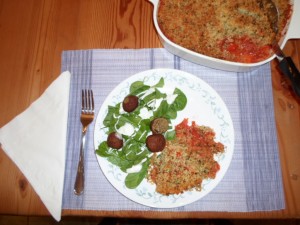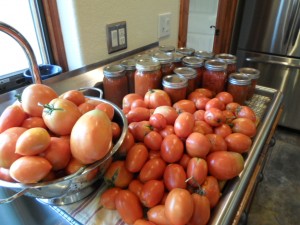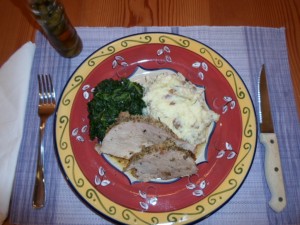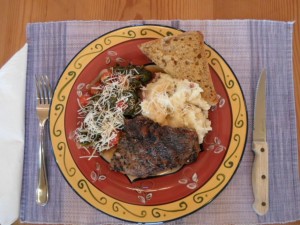Apple or other fruit crumbles are dessert favorites, but how about a savory tomato crumble for dinner? I ran across a recipe for one in a baking catalog and it looked interesting. It appeared to be a little bland – no onions, thyme, oregano – so I decided to rev it up with my own version.
Caramelized onions add richness to most savory dishes so I started with about 2 tablespoons of olive oil and 2 tablespoons of butter heating over medium heat in a large pot on the stove. I thinly sliced 3 medium-sized onions and added them with salt and pepper to the pan. Don’t let the onions burn, but instead slowly cook over lower heat and stir occasionally to make sure they are not sticking. After about 15 minutes, add a bay leaf and about 1 teaspoon each of dried thyme and oregano.
As the onions continue to cook, dice 3 garlic cloves and chop 10-12 medium-sized tomatoes with skins removed. After the onions have cooked for about 30 minutes, they should be a nice brown color. Stir in the garlic and tomatoes. Add about 3 tablespoons of flour, 1 tablespoon of brown sugar and stir. Reduce the heat to low and let the pot simmer for about 20 minutes, stirring occasionally. Taste for seasoning and add salt if needed.
Remove the tomato mixture from the heat and incorporate about a pint of cherry tomatoes or tomatoes chopped into bite-sized pieces. Spray a shallow casserole dish with cooking spray and pour in the tomato mixture.
For the crumble topping, mix together 2 cups plain bread crumbs, 1⁄2 cup grated Parmesan cheese, 1 tablespoon dried parsley flakes and 1 stick melted butter. Spoon the crumble over the top of the tomatoes in an even layer. Cook at 375 degrees for 20 minutes, until the topping is lightly browned. Remove from the oven and let cool for at least 10 minutes before serving.
I served the tomato crumble with a spinach salad for Sunday night’s dinner. This recipe is a keeper and would also go well as a side dish for baked fish – I’m thinking salmon.




